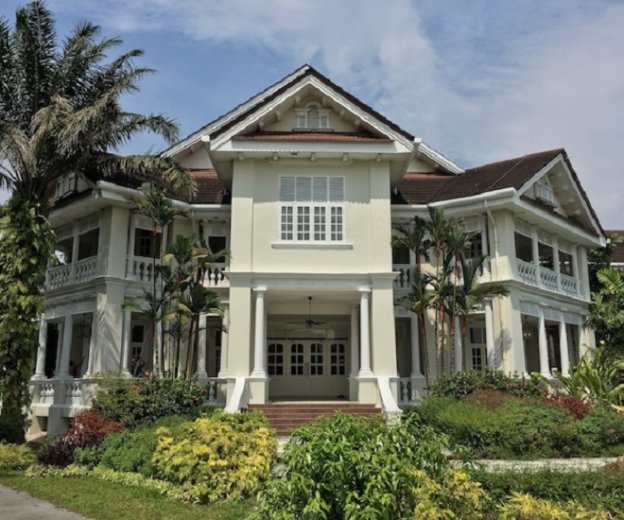
Exterior of Seri Negara, or King’s House. Image courtesy Alexander Leong
When KK Tan began working with an American fortune hunter back in 2004, he likely didn’t expect to emerge two years later with four containers’ worth of valuable Chinese artefacts entangled in wild tales of piracy and international politics. “Everything happened by fate or accident,” he joked.
The socio-political analyst began working with an American “pirate” to set up an Asian museum with the backing of the Malaysian government and several investors. When the deal fell through, the fortune hunter abruptly fled the country without paying Tan, and the Malaysian High Court order granted him ownership of the abandoned treasure.
When I visited Tan in a nondescript fluorescent-lit office in central Kuala Lumpur, I wasn’t expecting to stumble upon a literal pirate’s treasure trove. Amidst mountains of paper, folders and multiple copies of Crazy Rich Asians, over 2,000 priceless objects await their day in the sun. According to Tan the provenances of many of the pieces are pretty uncertain. Likely, some part of the American’s haul has some of its origins in the hands of the notorious 16th century pirate, Li-ma-hong, whose legacy included terrorising sailors in the South China Sea, and aspirations of his own Filipino kingdom.

Keris and ceremonial swords from the Malay Archipelago. Image courtesy Samantha Cheh
The total sum of the treasure is staggering: there are Spanish signal flares dating back to the time of Columbus, priceless Song Dynasty powder boxes, plates possibly from the infamous Lena shipwreck dredged up off the coast of Philippines, and a 2,500 year old “food vessel” from China’s Warring States period. The great bulk of Tan’s collection comes from China, though there are some fascinating artefacts from the Malay archipelago, including rare brass models of Malay sailing ships, Dabu Dabu drums, exquisite keris and swords from Southern Philippines and Indonesia.
AHM will be setting up shop in the Carcosa Seri Negara complex, which is made up of two buildings: the larger Carcosa house, originally constructed by Malaya’s first Resident, Frank Swettenham, in 1896; and the smaller “Seri Negara”, also known as “King’s House”, which used to house members of Malaya’s various royal families.
In Tan’s view, one of most valuable aspects of the treasure is its value as a bridge between cultures. AHM could be “a way to oppose the terrorism and extremism that’s plaguing the world today” through cultural exchange and discourse. To that end, Carcosa will become a “peace museum” which will house their superstar pieces, and be a reminder of the region’s multicultural roots.

Various examples of Chinese porcelain and pottery from the Asian Heritage Museum (AHM)’s shipwreck collection. Images courtesy Samantha Cheh
It will also feature a shipwreck gallery for AHM’s large shipwreck artefact collection which Tan says is likely the world’s largest. Shipwreck artefacts are becoming increasingly high in demand, though their value and nature is still largely a matter of academic research at this point. Tan said that experts expect that the value of shipwreck treasure will rise tenfold in the next five years.
Seri Negara will be turned into the Artefacts Trading and Performance Arts (ATP) Center, a business arts center targeted at promoting heritage items through live performances of all kinds, including recitals, history and nature walks, and the occasional auction.
AHM is also looking to disrupt the traditional idea of a museum, by inviting the active participation of researchers and students to study their artefacts and continuously build their knowledge base, rather than starting with detailed provenance records. “We challenge the traditional museum approach,” Tan said. “We want to be like Wikipedia, we want to share with the world and let the public contribute.”

A collection of Spanish doubloons from the Asian Heritage Museum (AHM)’s shipwreck collection. Image courtesy Samantha Cheh
AHM will be looking to deploy some of the latest technologies in order to appeal to younger generations, and combat the traditional notion that museums are boring. There are plans to introduce virtual reality and augmented reality capabilities to enhance visitors’ experience and draw large crowds, but also to connect it all in a compelling story of Asia’s rich cultural heritage.
By bringing these new technologies and lost treasures to the old bones of the elegant Carcosa complex, AHM is weaving together voices from across history into compelling story for the Malaysian public. After years as a luxury hotel, Carcosa was closed for refurbishment in 2015 but then left to languish. AHM is currently working to bring it back to life and back into the spotlight, making it relevant again as yet another aspect of the company’s cultural preservation work.
This article was written by Samantha Cheh for Art Republik.
More information at asianheritagemuseum.blogspot.my.




